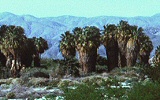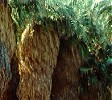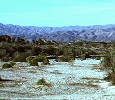Success stories: Tales of improving our native biodiversity
Tunyalee Martin/GIST
January 2001
Photographs
Click
on the images below to view photographs related
to this success story.

|

|

|

|
The Setting
The Coachella Valley Preserve conserves two rare habitat types. The
blown-sand fields are a combination of sandy wash, rocky slopes, and
alluvial plains created by surface water and wind sand movement. The palm
oasis woodlands are created when underground waters flowing from higher
elevation are halted by faulting and fracturing of bedrock. The water
rises to the surface and creates a precious habitat that sustains the palms
and a great variety of animals.
The preserve provides habitat for 180 wildlife species. Five rare species, the flat-tailed horned lizard, Coachella valley round-tailed squirrel, giant velvet mite, giant palm-boring beetle, and the federally listed endangered Coachella Valley fringe-toed lizard, inhabit the dune sands. Willow (Salix exigua), cottonwoods (Populus fremontii), common reed (Phragmites australis), and mesquite (Prosopis glandulosa and P. pubescens) are native riparian plants common in the oases. The Coachella Valley Preserve contains the last undisturbed watershed in the valley, a water source that carries the sand that creates and sustains the blown-sand fields.
The Invader - Tamarisk, Saltcedar (Tamarix ramosissima)
Tamarisk, a non-native species originally from southeastern Europe and
Asia, was planted in the Coachella Valley as a windbreak. Unfortunately,
this plant spread to other critical areas, out-competes native plants, and
uses a tremendous amount of water. In fact, as the tamarisk infestation on
the preserve got larger and larger an important spring dried up, apparently
because the tamarisk consumed all the water before it reached the surface.
Tamarisk provides few benefits to native wildlife and grows in stands so
dense, it crowds out native plants and prevents wildlife from accessing key
water sources.
A Success Story
"It can be done." So says Cameron Barrows who took on the
daunting task of reclaiming the Coachella Valley Preserve from tamarisk
invasion. The control effort removed tamarisk from several oases within
the preserve, but the main focus was in Thousand Palms Canyon where the
infestation was most severe. The 25 acre (10 ha) wetland had greater than
80% tamarisk cover over 70% of the wetland.
Removal of tamarisk was accomplished by volunteers and California Conservation Corps Crews beginning in the spring of 1986. The removal effort was concentrated during the cooler part of the year from November to April, with six to ten weekend removals per year. Successfully removing the tamarisk took five years, from 1986 to winter of 1991-1992 and a group effort of 5,000 person-hours. Currently, monitoring and the removal of seedlings blown in from adjacent areas requires only one to two work days annually.
Tamarisk trees were cut as close to the ground as possible with chainsaws or pruning shears and the stumps immediately sprayed with a herbicide from hand-held or backpack sprayers. Waiting to apply the herbicide more than a few minutes after cutting resulted in increased resprouting. Triclopyr (Garlon 3A and Garlon4) was used. One part herbicide was mixed with two or three parts water and applied using appropriate protective gear (long sleeves, gloves, eyewear). Most areas were cut by hand, thereby selectively cutting out the tamarisk while leaving the native shrubs unharmed. Only a 7.5 acre (3 ha) section that was heavily infested (more than 95%) was cleared using a bulldozer.
Experience proved that the most effective time to treat tamarisk was during the months of November through January when they were entering dormancy and storing resources in their roots. A systemic herbicide such as triclopyr is more likely to be translocated to the root system where it kills the underground parts of the plant. If the correct method of applying the herbicide is followed for each tree, mortality rates can be greater than 90%. However, with inconsistency in application that often occurs in large removal efforts, about 60-80% mortality can be expected with resprouting occurring from the remaining live stumps.
The cut debris were piled in inconspicuous places around the preserve rather than being hauled to a landfill, which was expensive, or burned since there was a danger of fire spreading to the dry palm skirts. The brush piles provided habitat for birds while the native vegetation recovered.
Remarkably, the spring in Thousand Palms Canyon began flowing again for the first time in years just hours after the first large tamarisk cutting effort there. Revegetation of all the cleared areas occurred quickly and inexpensively. Seeds were collected from nearby shrubs and trees and strewn onto the cleared areas after the tamarisk was removed. In the 7.5 acres (3 ha) that was bulldozed, natives established much more slowly than in the hand-cleared areas. Native inkweed, saltbush, quailbush and alkali goldenbush are now growing in dry areas and the desert fan palms, willows, cottonwoods, and common reed are well established in wet areas. It has been nine years since tamarisk was cleared from the Coachella Valley Preserve and there is almost no sign that tamarisk was once a dominant invader here. The natural vegetation has returned to normal levels and the piles of cut tamarisk, once 10-12 feet (3-3.7 m) high, are barely noticeable, having degraded to 4 foot (1.2 m) piles. Removing tamarisk restored natural habitats and natural processes such as the water flow which are vitally important to the survival of many native plants and animals here.
More Information
A review article with more detailed information about Tamarisk,
including a description of its diagnostic characteristics, range, ecology,
and methods for its control, is available on the TNC
Wildland Invasive
Species Team website.
References
Barrows, C.W. Tamarisk control: A success story.
Fremontia 20(3): 20-22.
Barrows, C.W. 2000. Personal communication
This document in other formats: MS Word, Adobe Acrobat
This article may be treated as a press release and may be quoted by the media in part or in full. Publication quality versions of images on this page can be obtained from the Wildland Invasive Species Team by sending email to bamrice(at)ucdavis.edu.


